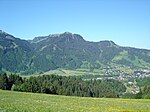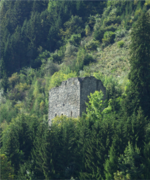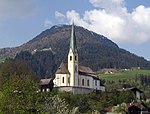Kleiner Rettenstein
Kitzbühel AlpsMountains of Salzburg (state)Mountains of Tyrol (state)Mountains of the AlpsSalzburg geography stubs ... and 2 more
Two-thousanders of AustriaTyrol geography stubs
The Kleiner Rettenstein is a 2,216-metre-high (7,270 ft) mountain in the Austrian state of Tyrol. It lies in the Kitzbühel Alps, roughly east of its larger brother, the Großer Rettenstein.
Excerpt from the Wikipedia article Kleiner Rettenstein (License: CC BY-SA 3.0, Authors).Kleiner Rettenstein
Geographical coordinates (GPS) Address Nearby Places Show on map
Geographical coordinates (GPS)
| Latitude | Longitude |
|---|---|
| N 47.33694 ° | E 12.34167 ° |
Address
Rettensteinalm
6365
Austria
Open on Google Maps









